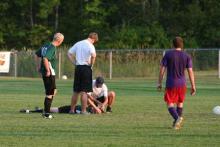Head contact with other players, not with the ball, is the main source of concussions among high-school soccer players of both sexes, according to a report published online July 13 in JAMA Pediatrics.
Several studies have shown that “heading” the ball during soccer practices and games is responsible for many soccer-related concussions, and some have called for banning such heading, especially among children and adolescents, to make the sport safer. But until now, no large study has examined the exact mechanism of head injuries among school-aged soccer players, so such prevention efforts cannot be considered evidence based, said R. Dawn Comstock, Ph.D., an epidemiologist at the University of Colorado Denver, Aurora, and her associates.
The investigators performed a retrospective analysis of data from a large, Internet-based sports injury surveillance study, focusing on concussions sustained during soccer practices or games which required medical attention and restricted the athlete’s participation for 1 or more days. They assessed nationally representative samples of 100 high schools every year for a 9-year period. There were 627 concussions during 1,393,753 athletic exposures among girls (4.50 per 10,000 exposures) and 442 concussions during 1,592,238 athletic exposures among boys (2.78 per 10,000 exposures).
The most common mechanism of concussion was player-to-player contact among both boys (68.8% of concussions) and girls (51.3% of concussions). In contrast, contact with the ball accounted for 17% of concussions among boys and 29% among girls.
The number and types of concussion symptoms were the same, regardless of whether the concussion was caused by player-to-player contact or player-to-ball contact. However, symptom resolution time was slightly but significantly longer for both boys and girls when the concussion was caused by collision with a ball or goal post (JAMA Pediatr. 2015 July 13 [doi:10.1001/jamapediatrics.2015.1062]).
“We postulate that banning heading from soccer will have limited effectiveness as a primary prevention mechanism (i.e., in preventing concussion injuries) unless such a ban is combined with concurrent efforts to reduce athlete-athlete contact throughout the game,” Dr. Comstock and her associates said.
Moreover, “it may be culturally more tolerable to the soccer community to attempt to reduce athlete-athlete contact across all phases of play through better enforcement of existing rules, enhanced education of athletes on the rules of the game, and improved coaching of activities such as heading,” rather than simply banning heading, they added.


